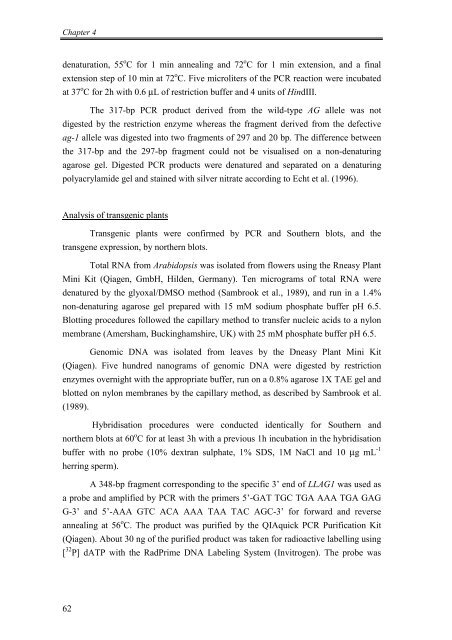Flower development of Lilium longiflorum - The Lilium information ...
Flower development of Lilium longiflorum - The Lilium information ...
Flower development of Lilium longiflorum - The Lilium information ...
Create successful ePaper yourself
Turn your PDF publications into a flip-book with our unique Google optimized e-Paper software.
Chapter 4<br />
denaturation, 55 o C for 1 min annealing and 72 o C for 1 min extension, and a final<br />
extension step <strong>of</strong> 10 min at 72 o C. Five microliters <strong>of</strong> the PCR reaction were incubated<br />
at 37 o C for 2h with 0.6 µL <strong>of</strong> restriction buffer and 4 units <strong>of</strong> HindIII.<br />
<strong>The</strong> 317-bp PCR product derived from the wild-type AG allele was not<br />
digested by the restriction enzyme whereas the fragment derived from the defective<br />
ag-1 allele was digested into two fragments <strong>of</strong> 297 and 20 bp. <strong>The</strong> difference between<br />
the 317-bp and the 297-bp fragment could not be visualised on a non-denaturing<br />
agarose gel. Digested PCR products were denatured and separated on a denaturing<br />
polyacrylamide gel and stained with silver nitrate according to Echt et al. (1996).<br />
Analysis <strong>of</strong> transgenic plants<br />
Transgenic plants were confirmed by PCR and Southern blots, and the<br />
transgene expression, by northern blots.<br />
Total RNA from Arabidopsis was isolated from flowers using the Rneasy Plant<br />
Mini Kit (Qiagen, GmbH, Hilden, Germany). Ten micrograms <strong>of</strong> total RNA were<br />
denatured by the glyoxal/DMSO method (Sambrook et al., 1989), and run in a 1.4%<br />
non-denaturing agarose gel prepared with 15 mM sodium phosphate buffer pH 6.5.<br />
Blotting procedures followed the capillary method to transfer nucleic acids to a nylon<br />
membrane (Amersham, Buckinghamshire, UK) with 25 mM phosphate buffer pH 6.5.<br />
Genomic DNA was isolated from leaves by the Dneasy Plant Mini Kit<br />
(Qiagen). Five hundred nanograms <strong>of</strong> genomic DNA were digested by restriction<br />
enzymes overnight with the appropriate buffer, run on a 0.8% agarose 1X TAE gel and<br />
blotted on nylon membranes by the capillary method, as described by Sambrook et al.<br />
(1989).<br />
Hybridisation procedures were conducted identically for Southern and<br />
northern blots at 60 o C for at least 3h with a previous 1h incubation in the hybridisation<br />
buffer with no probe (10% dextran sulphate, 1% SDS, 1M NaCl and 10 µg mL -1<br />
herring sperm).<br />
A 348-bp fragment corresponding to the specific 3’ end <strong>of</strong> LLAG1 was used as<br />
a probe and amplified by PCR with the primers 5’-GAT TGC TGA AAA TGA GAG<br />
G-3’ and 5’-AAA GTC ACA AAA TAA TAC AGC-3’ for forward and reverse<br />
annealing at 56 o C. <strong>The</strong> product was purified by the QIAquick PCR Purification Kit<br />
(Qiagen). About 30 ng <strong>of</strong> the purified product was taken for radioactive labelling using<br />
[ 32 P] dATP with the RadPrime DNA Labeling System (Invitrogen). <strong>The</strong> probe was<br />
62














